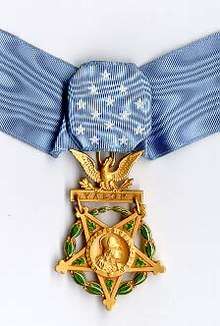Max Thompson (Medal of Honor)
Max Thompson (July 21, 1922 – November 30, 1996) was a United States Army soldier and a recipient of the United States military's highest decoration—the Medal of Honor—for his actions in World War II.
Max Thompson | |
|---|---|
 | |
| Born | July 21, 1922 Bethel, Haywood County, North Carolina |
| Died | November 30, 1996 (aged 74) Haywood County, North Carolina |
| Place of burial | Forest Lawn Cemetery, Enka, North Carolina |
| Allegiance | United States of America |
| Service/ | United States Army |
| Rank | Technical Sergeant |
| Unit | 3rd Battalion, 18th Infantry Regiment, 1st Infantry Division |
| Battles/wars | World War II |
| Awards | Medal of Honor Purple Heart Order of Glory (Soviet Union) |
Born in the community of Bethel in Haywood County, North Carolina, Thompson joined the Army from Prescott, Arizona[1][2] on 18 November 1942.[3] By October 18, 1944, he was serving in Europe as a sergeant in Company K, 18th Infantry Regiment, 1st Infantry Division. During a battle on that day, near Haaren, Germany, he single-handedly attacked the German forces on several occasions. For his actions, he was awarded the Medal of Honor eight months later, on June 18, 1945.[1] He was one of two people from Haywood County, North Carolina, to receive the medal in World War II, the other being William D. Halyburton, Jr..[2]
In addition to the Medal of Honor, Thompson also received the Purple Heart and, from the Soviet Union, the Order of Glory, third class, a Presidential Unit Citation with two Oak Leaf Clusters, the Good Conduct Medal, and the European theatre ribbon (with five battle stars and the Invasion arrow). He reached the rank of technical sergeant before leaving the Army.[2]
Max Thompson was just a modest, soft-spoken young man, who preferred showing his discharge papers rather than his Medal of Honor or any of his other awards. On his return home, he would willingly talk about Fort Bragg and other places in the US, but would close up when anyone would mention the battles in Europe where he fought and won all those deserved honours. He was quiet, unassuming and a mild-mannered fellow who preferred the peace and quiet of fishing. When he enlisted, he was 5'8 1/2" tall and was blonde haired and blue eyed.[4] Max always made good grades in school, and played basketball. He graduated in 1940 and his favorite subject was mathematics. Food preferences? Bread and milk! His mother said that he always took that above anything else she would cook. Before Max enlisted, he was employed at Champion Paper and Fibre Company.
During heavy fighting one day, he and a buddy were in a foxhole, covered with a raincoat, trying to light a cigarette, when a shell hit somewhere nearby. The shell blew in the sides of the foxhole, and the concussion punctured both of Max's eardrums. A piece of shrapnel went through his helmet, and had he been standing up, instead of bending over lighting his smoke, the same shrapnel would have killed him.[5]
After his military service, Thompson worked in Canton, North Carolina, for Champion International Paper's inspection department.[2] He died at age 74 on November 30, 1996, and was buried at Forest Lawn Cemetery in Enka, North Carolina.[2][6] A road in near Canton was renamed in his honor.
Medal of Honor citation
Sergeant Thompson's official Medal of Honor citation reads:
On 18 October 1944, Company K, 18th Infantry, occupying a position on a hill near Haaren, Germany, was attacked by an enemy infantry battalion supported by tanks. The assault was preceded by an artillery concentration, lasting an hour, which inflicted heavy casualties on the company. While engaged in moving wounded men to cover, Sgt. Thompson observed that the enemy had overrun the positions of the 3d Platoon. He immediately attempted to stem the enemy's advance single-handedly. He manned an abandoned machinegun and fired on the enemy until a direct hit from a hostile tank destroyed the gun. Shaken and dazed, Sgt. Thompson picked up an automatic rifle and although alone against the enemy force which was pouring into the gap in our lines, he fired burst after burst, halting the leading elements of the attack and dispersing those following. Throwing aside his automatic rifle, which had jammed, he took up a rocket gun, fired on a light tank, setting it on fire. By evening the enemy had been driven from the greater part of the captured position but still held 3 pillboxes. Sgt. Thompson's squad was assigned the task of dislodging the enemy from these emplacements. Darkness having fallen and finding that fire of his squad was ineffective from a distance, Sgt. Thompson crawled forward alone to within 20 yards of 1 of the pillboxes and fired grenades into it. The Germans holding the emplacement concentrated their fire upon him. Though wounded, he held his position fearlessly, continued his grenade fire, and finally forced the enemy to abandon the blockhouse. Sgt. Thompson's courageous leadership inspired his men and materially contributed to the clearing of the enemy from his last remaining hold on this important hill position.[1]
References
- "Medal of Honor Recipients - World War II (T–Z)". Medal of Honor Citations. United States Army Center of Military History. August 3, 2009. Archived from the original on December 31, 2009. Retrieved November 12, 2010.
- Stockton, Ron (November 11, 2010). "2 Haywood County World War II heroes among few to get Medal of Honor". Asheville Citizen-Times. Asheville, North Carolina. Archived from the original on November 14, 2010.
- WWII Army Enlistment Records
- "Ancestry WWII Draft Registration Cards". www.ancestry.com. Retrieved 2017-06-01.
- "The Waynesville Mountaineer, 4 October 1945".
- "Max Thompson". Claim to Fame: Medal of Honor recipients. Find a Grave. Retrieved 2007-10-03.